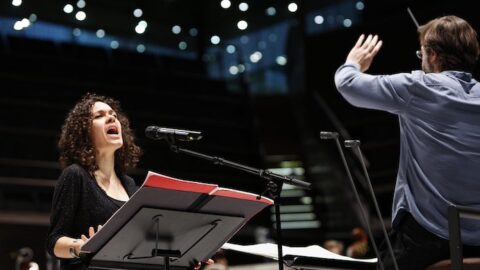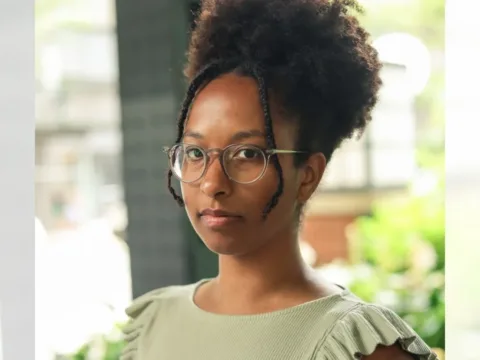Musica nova Helsinki is Finland’s largest contemporary music festival, and this year’s twelve-day event kicked off on February 1, 2017 with a concert of both Finnish and world premieres at the Helsinki Music Centre. The circular, vineyard-style concert hall visually reflected the theme of the 2017 festival: “open spaces.” With patrons surrounding the orchestra on all sides, the Finnish Radio Symphony Orchestra (FRSO), led by festival artistic director André de Ridder, presented a brilliantly-performed and well-balanced program of works by Michel va der Aa, Andrew Norman, and up-and-coming Finnish composers Sauli Zinovjev and Sebastian Hilli.
The evening opened with the world premiere of Sauli Zinovjev’s Batteria, which served as an exploration of swells, decay, and pulse as these elements cross-faded throughout the ensemble. The piece opens with insistent quarter notes in the percussion, string crescendos, and bell-tone like chords. Triumphant brass lines led by stopped horns sing out from atop massive crescendos, and each swell allows for subsequent sonic decay. The quarter-note pulse in the percussion transforms into a clock-like tick in the bells, harp, piccolo, and high register pizzicato violins before the strings and winds trade rushing scales that build to a climatic finale. The 10-minute work feels like a film score in that distinct musical scenes join to form a complete narrative.

Michel van der Aa’s song cycle Spaces of Blank for mezzo-soprano, orchestra, and soundtrack combines five poems by Emily Dickinson, Anne Carson, and Rozalie Hirs over three movements, and all of the selected poems reference space as a metaphor for anxiety. Throughout the work, this anxiety is musically portrayed through obsessive and repetitive gestures, dissonant brass outcries, frenetic string lines, and syncopated unstable rhythms. The first movement opens with a moment of calm featuring shimmering electronics, sustained brass chords, and delicately-sprinkled interjections from the high register of the piano. The string section introduces feeling of anxiety with agitated articulations that sometimes subside during the vocal soliloquies, but other times, continue bubbling below the surface. The vocal solo, sung with theatrical vigor by Dutch soprano Nora Fischer, ranges from pleading to pained to intimately whispered as the music shifts from calm to frantic, then back to calm.
The second movement follows this same emotional arc, beginning with solemn low string tones and a barely audible vocal melody. Then, bursts of electronics crash in to the texture and the vocal part swells to join the trumpet in unison. This moment of calamity dissipates, and the movement ends as it began with gentle sustained tones. The third movement features a rapid-fire pulse in the soundtrack, which is acoustically matched by tremolos in the strings. This contained yet frenzied pulse persists under the voice and continues to spread throughout the orchestra as rapidly articulated percussion and brass flutter tonguing join the fray. Despite the heightened anxiety that dominates the majority of the movement, the piece concludes with an emotionally-detached, stagnant declaration of the final stanza (“spaces of blank approach us/they move in hurry from white to/black to white away and back”) accompanied by cold, metallic percussion.
The final piece before intermission was the Finnish premiere of Sebastian Hilli’s Reachings. The 13-minute work is a pastiche of sound events including sustained low strings, forceful pizzicato snaps, stabs of staccato muted brass, bowed tam tam, and a serene dialogue between the violins and the vibraphone. About half-way through, a complete melody finally emerges in the flute and oboe, though this brief moment of conjunct, lyrical stability is supplanted by disjunct, full ensemble motivic spurts that built to the conclusion. Regarding the performance by the FRSO, de Ridder noted in a separate conversation that the primary function of many European radio orchestras is still to promote contemporary music, but regardless, it is both impressive and encouraging to see an ensemble dedicated to producing high-caliber performances of new music by young composers.

After intermission, the evening concluded with the Finnish premiere of Andrew Norman’s Play. I had just heard the Cincinnati Symphony Orchestra’s performance of this work two weeks prior at the MusicNOW festival, so naturally, I had a certain expectation as to what I was about to hear—however, the FRSO and de Ridder brought this piece to life in a way that created a dazzling new listening experience. “Level One” was faster and crisper with a more tightly-wound energy. Before the orchestra began, de Ridder showed a gesture that demonstrated this percolating energy, which immediately burst out of the ensemble from the first downbeat. There was a brilliance to every articulation, crescendo, release, and string of virtuosic 16th notes, which created clarity in the calamity of the multi-layered interactions between sections of the orchestra. Some of the smaller details also came across with greater definition. The “almost inaudible groove” that begins “Level Two” revealed much greater nuance in the sounds of col legno taps and the sliding of fingers over strings. The ability to hear these gestures in greater detail drew the audience inward from the openness of the concert hall and created a much more interactive and intimate experience. Contrastingly, “Level Three” built to a gorgeous climax that filled the entire room before gently dissipating to the end.
The FRSO’s familiarity with and dedication to contemporary music is highly laudable to say the least, and the acoustics of the Helsinki Music Centre are superb. This, coupled with de Ridder’s firm command of the repertoire, made for an exciting festival opening featuring a superlative evening of premieres.
























